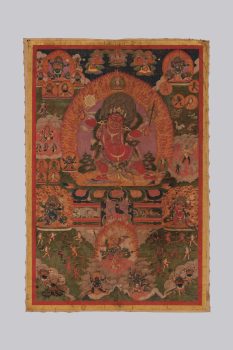Tibet
19th century


Tibet
19th century


Takla Membar, the Flaming Tiger-God, is an important deity of Bon, a religion indigenous to Tibet. Although his primary role is that of a meditational deity, Takla Membar is also considered a doctrinal weapon because practitioners employ him in meditation against Buddhists whenever the Bon religion is suppressed. While Bon imagery draws heavily on Buddhist tantric imagery, unique iconographic features, such as the weapon of nine crossed swords, indicate that this is a Bon painting. Bon coexisted with Buddhism for centuries in some communities, and local painters created works of both religious traditions, thus drawing on the same visual vocabulary.The deep, flat blue and gray hues suggest this painting might be from southern Amdo or northern Kham Province, where the Bon religion flourished in the eighteenth and nineteenth centuries.
A religious movement that originated in India around the fifth to seventh century with sacred writings and esoteric teachings and practices transmitted from teacher to student through initiation. These remain an important part of Hinduism and Buddhism today.
A contemplative practice in which a person uses concentration and visualization to achieve aims such as transforming the mind and generating feelings of compassion. Techniques include focusing on breathing or visualizing oneself as a deity.
Protectors of Buddhist teachings who destroy obstacles that impede the path to enlightenment. The more frightening and gruesome their appearance, the greater their power.
Today, Tibetans primarily inhabit the Tibetan Plateau, situated between the Himalayan mountain range and the Indian subcontinent to the west, Chinese cultural regions to the east, and Mongolian cultural regions to the northeast. During the 7th to 9th century, Tibetan rulers expanded their empire across Central Asia, and established Buddhism as the state religion.
Get the latest news and stories from the Rubin, plus occasional information on how to support our work.